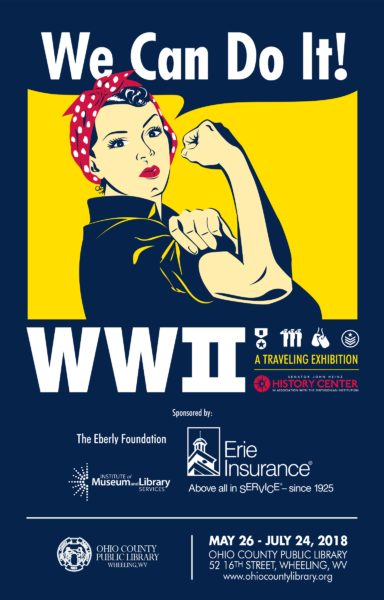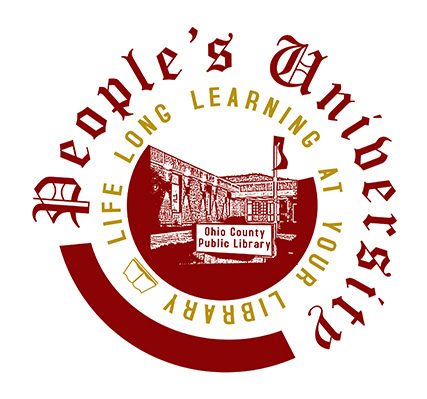World War II is the subject of the upcoming Ohio County Public Library’s People’s University series, which will feature an impressive array of historians and experts. It will run in conjunction with the “We Can Do It! WWII” Traveling Exhibit from the Senator John Heinz History Center in Pittsburgh, on display at the Ohio County Public Library May 26 through July 24.
The 500-square-foot “We Can Do It! WWII” Traveling Exhibit explores Western Pennsylvania’s impact on the home, industrial and battlefronts during WWII, and includes artifacts, previously unseen photographs and large museum panels highlighting Western Pennsylvania’s contributions to WWII, as well as lifelike museum figures of local WWII heroes. The exhibit will be supplemented with Wheeling-related WWII-era artifacts. The Ohio County Public Library was one of 15 organizations — and the only site in West Virginia — selected to host the exhibit over a three-year period.
The grand opening of the exhibit will take place on Saturday, May 26, starting with a reception at 1 p.m., and will include a visit by “Rosie the Riveter,” music, cake and tours of the exhibit led by a Heinz History Center representative. The exhibit will be available to the public during all open library hours.

A variety of WWII-related programs, including the People’s University, World War II, will also take place throughout the duration of the exhibit. The People’s University, World War II, will meet at 7 p.m. Tuesday evenings from May 29 through July 24 in the library’s auditorium. There will be no class on July 3 because of the Independence Day holiday.
The full schedule for the People’s University, World War II is as follows:
CLASS 1: TUESDAY, MAY 29
A RETURN TO NORMALCY: AMERICA BETWEEN THE WARS
The decades of the 1920s and 1930s were separated from the past and the future by two catastrophic world wars. President Harding’s 1920 election campaign called for a “Return to Normalcy” — “America’s present need is not heroics, but healing; not nostrums, but normalcy … not submergence in internationality, but sustainment in triumphant nationality.” The next two decades would bring both roaring prosperity and great depression before the outbreak of a second world war in the 1940s.
INSTRUCTOR: DR. DAVID JAVERSAK grew up in Weirton and was educated at West Liberty State College, the University of Hawaii and WVU. He is Dean Emeritus of Liberal Arts and Professor Emeritus of History at West Liberty University.
CLASS 2: TUESDAY, JUNE 5
HITLER, MUSSOLINI and TOJO: THE PRELUDE TO WAR
Economic crisis not only hit the United States but spread to other countries, triggering social unrest and ethnic violence. Politicians saw opportunity in fear and chaos. Benito Mussolini became prime minister of Italy in 1922, Adolph Hitler became chancellor of Germany in 1933, quickly establishing himself as dictator, and in the 1930s, Tôjô Hideki, rose through the ranks of the Japanese Army, becoming Minister of War in 1940, then Prime Minister in 1941. In the years leading up to World War II, major allies underestimated Germany, Italy and Japan’s expansion plans and a failure of the policy of appeasement meant war was all but unavoidable.
INSTRUCTOR: DR. GARY KAPPEL is Perry E. & Aleece C. Gresham Chair in Humanities and Professor of History at Bethany College, teaching courses in World History, European History and Military History. He earned his B.A. at Bethany College, and his M.A. and Ph.D. at West Virginia University.
CLASS 3: TUESDAY, JUNE 12
BLITZKRIEG, BOMBS and BATTLES: THE ROAD TO D-DAY
On Sept. 1, 1939, Nazi Germany invaded Poland, and World War II officially began. Western technological advances had brought about the most destructive war in human history as the Axis nations (Nazi Germany, Fascist Italy, Imperial Japan) fought the Allied nations (Great Britain, the Soviet Union, and later, the U.S.) in the European, the Pacific, and the Mediterranean, African & Middle East Theatres. The pivotal Battle of Normandy, beginning with the June 6th D-Day invasion in 1944, marked the beginning of the end of war in Europe.
INSTRUCTOR: DR. GARY KAPPEL
CLASS 4: TUESDAY, JUNE 19
ON THE HOME FRONT and ABROAD: WEST VIRGINIA and WHEELING IN WWII
With the Japanese bombing of Pearl Harbor on Dec. 7, 1941, West Virginia and the nation again went to war. West Virginia reported the fifth-highest percentage of servicemen during the war, with 218,665 serving in the armed forces. While our West Virginians fought abroad, local industries — such as Wheeling Corrugating — started manufacturing materials for the war efforts.
INSTRUCTOR: DR. HAL GORBY is Teaching Assistant Professor and Director of Undergraduate Advising at West Virginia University where he teaches West Virginia and Appalachian History and Immigration, Ethnic History, U.S. Working Class, and 20th Century U.S. He earned his B.A. from Wheeling Jesuit University, and his M.A. and Ph.D. degrees from West Virginia University.
CLASS 5: TUESDAY, JUNE 26
ON THE HOME FRONT and ABROAD: WOMEN IN WWII
As widespread male enlistment left gaping holes in the industrial labor force, American women entered the workforce in unprecedented numbers. “Rosie the Riveters” worked in defense plants and volunteered for war-related organizations while still managing households. Additionally, nearly 350,000 American women joined the military, serving both at home and abroad, volunteering as WAACs, WAVES, SPARS and WASPS, working as nurses, truck drivers, airplanes mechanics and in clerical positions.
INSTRUCTOR: DR. JERRA JENRETTE is Professor of History, Department of History, Anthropology and World Languages at Edinboro University of Pennsylvania. She earned her B.A. from Mars Hill College, M.A. from Appalachian State Universit, and her Ph.D. from West Virginia University.
CLASS 6: TUESDAY, JULY 10
ON THE HOME FRONT and ABROAD: AFRICAN-AMERICANS IN WWII
African-American soldiers saw WWII as a two-front battle. Drawing the connection between fascism abroad and hate at home, pre-Civil Rights activists declared the necessity of “double victory.” On the home front, African-American “Rosie the Riveters” fled lives as domestics and sharecroppers to empower themselves, working in war production and U.S. government offices while fighting both racism and sexism.
INSTRUCTOR: GREGORY COOKE is Adjunct Assistant Professor in the Department of English and Philosophy at Drexel University in Philadelphia. Cooke has researched, written and produced two historical documentaries about the African-American experience during World War II, “Choc’late Soldiers from the USA” and “Invisible Warriors: African-American Women in World War II.” He earned his B.A. in English from the American International College and his M.A. in Journalism from The Ohio State University.
CLASS 7: TUESDAY, JULY 17
ON THE HOME FRONT and ABROAD: THE HUMAN COST
Six million Jews and more than five million non-Jews, including Gypsies, homosexuals, blacks, and the physically and mentally disabled, were persecuted and murdered by the Nazi regime and its collaborators. But the human cost of “total war” didn’t stop there. From the U.S. internment of Japanese, German and Italian citizens, to the Soviet-forced labor gulags, to Japanese death marches and hell ships — the impact of the war on humankind is incomprehensible. Estimates of the final death toll, including military casualties, genocide, and war-related diseases and famine, range as high as 80 million people, with as many as 50 million civilians.
INSTRUCTOR: DR. JEFF RUTHERFORD is Assistant Professor of History at Wheeling Jesuit University. He earned his B.A. at SUNY at Binghamton, his M.A. at SUNY at Albany and his Ph.D. from University of Texas at Austin.
CLASS 8: TUESDAY, JULY 24
V-E and V-J: VICTORY, THE END OF WAR and THE AFTERMATH
By the end of August 1944, Allies had liberated Paris. Allied forces then prepared to enter Germany, where they would meet up with Soviet troops. On May 8, 1945, the Germans surrendered, while war with Japan continued. On Aug. 6, an American B-29 dropped an atomic bomb on Hiroshima, killing more than 70,000 people and destroying a 5-square-mile expanse of the city. Three days later, the U.S. dropped a second atomic bomb on Nagasaki, killing another 40,000. On Aug. 14, 1945, the Japanese surrendered, ending WWII. The UN was formed following of the war while the simultaneous rise of two superpowers, the U.S.S.R. and U.S., would divide Europe into two Blocs and former allies would engage in a Cold War.
INSTRUCTOR: DR. JOE LAKER is Emeritus Professor of History at Wheeling Jesuit University and a member of the West Virginia Independence Hall Foundation. He earned his B.A. at Marian College and his M.A. and Ph.D. at Indiana University.
In keeping with the mission of public libraries as sanctuaries of free learning for all people, the Ohio County Public Library created the People’s University, a free program for adults who wish to continue their education in the liberal arts. The People’s University features courses — taught by experts in each subject — that enable patrons to pursue their goal of lifelong learning in classic subjects such as history, philosophy, and literature.
All classes are free and open to the public. Patrons may attend as many classes as they wish. There are no tests or other requirements. To register for the People’s University, World War II, email the library at ocplarchives@gmail.com, call 304-232-0244 or visit the Reference Desk.



